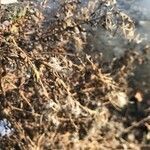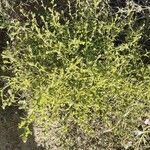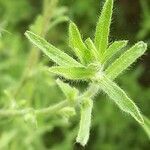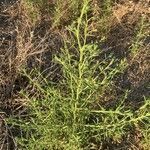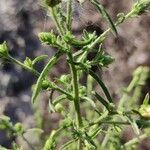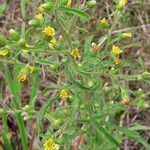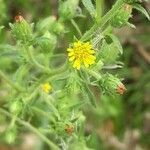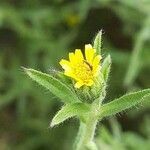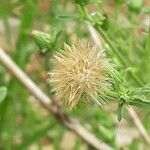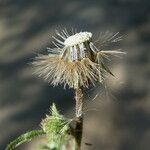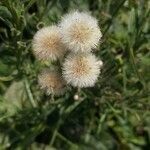Erect, strongly scented annual, up to c. 1 m tall. Stems moderately hairy and glandular, much-branched from base and above. Lower lvs moderately clothed in simple hairs and short glandular hairs, oblanceolate to narrowly elliptic-oblong, apetiolate and cuneate, acute to acuminate, entire or remotely denticulate, 20-80 × 2-10 mm; uppermost lvs smaller, broader based and becoming ± linear and entire. Capitula solitary, 4-10 mm diam. Outer involucral bracts mostly herbaceous, 3-4 mm long; inner bracts mostly membranous, 5-7 mm long. Ray florets c. 8-10; ligules yellow, 1-3 mm long, not exceeding involucre. Disc yellow, often turning red on drying. Achenes hairy, glandular toward apex, obovoid and slightly angled, c. 2 mm long; pappus minutely barbellate.
Erect, viscid, aromatic annual, to 40 cm high. Leaves narrowly oblong-elliptic and remotely dentate, to linear and entire, to 4 cm long, glandular-puberulous and sparsely villous. Capitula in an open pyramidal panicle; involucre cylindrical, c. 6–8 mm long, subtended by short foliage leaves; outer bracts lanceolate, recurved, green, glandular and pilose; intermediate bracts narrowly oblong, apiculate, with green glandular stereome and broad scarious margins. Ray florets c. 6, uni-seriate; ligule c. 4 mm long, shortly exceeding bracts, yellow. Disc florets c. 12; corolla shortly 4-lobed, yellow or reddish with age; style branches short, narrowly oblong, obtuse. Achene narrowly obovoid, c. 2 mm long.
Plants viscid, rank smelling, 20-130 cm; stems ±pilose and stipitate-glandular. Leaf blades linear to lance-linear, 1-3(-7) cm x 1-3(-10) mm, margins entire or denticulate, apices acute, faces pilosulous to hirtellous and minutely stipitate-glandular. Phyllaries 1-8 mm. Ray florets (6-)10-12(-16); corolla laminae 2-5(-7) mm. Disc florets 9-14+; corollas 3-4 mm. Cypselae 1.5-2.0 mm; pappi 3-4(-5) mm.
A herb. It has a strong smell. It grows 20-130 cm tall. The leaves are narrow and 3-7 cm long by 1-3 mm wide. There can be teeth along the edge. They taper to the tip.
